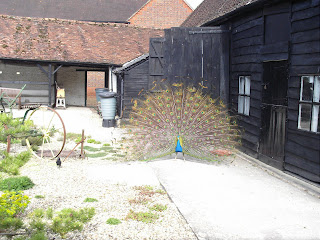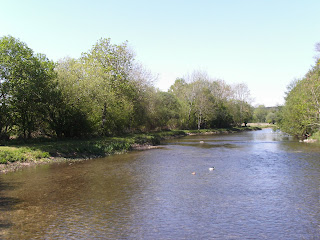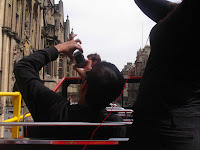I'm not long back from a week spent in a Grade 1 listed country house, and am now analysing the experience.
Littlecote was established in medieval times, grew to prominence in the Tudor period, had strong Parliamentarian connections later, and eventually developed into a Victorian gentleman's family home with extensive gardens and parkland. In the late 20th century it fell into the hands of business man Peter de Savary. Financial difficulties saw it become part of a holiday chain that caters for child-free holidays. It's possible to sleep in one of the few “historic” bedrooms, but main accommodation is in a purpose-built and sympathetically designed apartment complex close by the old manor house.
 |
| South front and entrance |
 |
| North front from gardens |
Arriving privately by car is part of the experience – as you leave the nearby town of Hungerford the road leads you deeper into the countryside around the Berkshire/ Wiltshire borders. Rolling green farmland is topped off by groves of large trees, and woodland springs up as you meander along. The ground rises steeply, then falls again and around a bend you come across a pair of brick pillars in deep shade. The winding leaf-littered drive suddenly turns 90 degrees, descending steadily, and Littlecote is laid out before you. The house lies quite secluded in the broad sunlit natural basin of the valley of the River Kennet which flows through the grounds. I suspect that, should you arrive in a coach party, the experience of arriving is somewhat spoilt since the shock of the view is obscured by all the other heads: and then you are tipped out into a courtyard to be surrounded by Craft Shops and everyone else's luggage.

What I mostly learned about Oxford was to come back in the winter. But we did meet an Inklings fan about to celebrate her eleventy-first birthday with her niece (she was 70½ and her niece 40½ ...work it out!!). We helped her carry her enormous cake, decorated with a dragon in a starry sky, to the Park & Ride. Now that was magical!
Our room overlooked the old carriage yard, and in the near distance was the jumbled roof-line of the old house. A magnificent peacock stalked the lawns below. Original features are blended relatively seamlessly with modern convenience. There are venerable pig sties, a walled garden, and clipped box hedges that rub shoulders with the modern dining and entertainment suites.
 |
| Peacock displaying in the carriage yard |
The old house is preserved yet accessible, less like visiting, say, Ickworth or Longleat – little is roped off or “forbidden” territory. A team of re-enactors are employed to stroll about the grounds looking “authentically” Tudor, the era chosen by the new owners to be emphasised as part of the historical aura of your stay. They also conduct you on guided tours of the house – though you are free to wander and relax on your own if you choose – or they perform vignettes throughout the day relating to Shakespeare, or Henry VIII's first meeting with Jane Seymour. It's best to let yourself be “taken in” by these antics, and they did seem reliably informed as well as being wittily delivered. More serious local historians conduct you around the mounds of the medieval village, erased in the early 16th century to create the deer park, and they explain the Roman ruins complete with genuine mosaic floor.
Your stay at Littlecote can be as cerebrally stimulating as you wish. But there are also activities such as archery, rifle shooting, bowls, a fitness suite, dance and art classes, opportunities to indulge in a variety of handicrafts. Littlecote is now, after all, in the business of providing holidays and making profits. But wait – I'm beginning to sound like a copy-writer for their bulky brochure!
We absorbed what the “resort” had to offer at our own pace. One day we drove into Hungerford and then busy Marlborough on market day, bought postcards and drank tea. But mostly we stayed in the peaceful seclusion of Littlecote's parkland and explored on our own. The margin of a nearby ploughed field revealed pieces of medieval tiles. The excavated Roman bath house, villa and temple were well-enough away from the hotel's other activities to produce a feeling of reverie. The immediately surrounding lanes and pathways were quiet, and lead back and forth across the rapidly flowing and crystal clear River Kennet with all its wildlife. Across the valley one evening I heard the sound of a cuckoo calling – something I once used to hear in my part of Suffolk but that has been missing there for many years. And, of course, there was the persistent and haunting cry of the peacocks.
 |
| River Kennett |
The day we left Littlecote we were due to take up a night's stay at The Holiday Inn, Aylesbury, an item that my husband bid for at a charity golf-day last year. As I had often wanted to visit, but had only ever passed through on my way to somewhere else, we decided to spend the day in Oxford – as history tourists, naturally. If Littlecote had shown us the sublime, then Oxford shattered all my illusions. Where had the townsfolk gone? Had they all been replaced by alien bodysnatchers with tourists of every nationality in creation? It was like one of Dante's circles of hell, with bodies seething and surging, and the traffic aiming to run you down at every corner. I know – we were tourists too. And Oxford is not a museum. How many times have I reminded myself of that aspect of history trips?
In my teens my father gave me a book entitled simply “Oxford & Cambridge”, a book of photographs with an introduction by Raymond Postgate. My edition was published in 1961, but from the largely monochrome plates of the various colleges, I guess it spoke more of the 1950s. Postgate's opinion was that “Oxford is more beautiful piece by piece. Cambridge is more beautiful as a whole.” He also said that “Oxford is overcrowded and out noised (if that is a word) by an external and alien plague.” He was referring to the motor-car and the Morris car factory at Cowley. I should have paid more attention! Instead of leafing for years through those calm images of deserted quadrangles and near-empty streets, I should have been re-reading that introduction...
So I was quite unprepared for that hellish town on a hot day. After trying in vain to dodge Mr Morris's progeny we decided to climb on board an open-topped bus for an hour. There was a cool breeze, and surely we would see so much better from up there. Well, the microphone of the tour guide appeared to have been switched off – not a word could we make out. The personal plug-in headphone technology died halfway round the city. And a couple in front of us seemed determined to photograph every single brick and roof-tile, standing up and down, lunging and swerving, completely blocking all the views.
 |
| Bahh! tourists!! |

What I mostly learned about Oxford was to come back in the winter. But we did meet an Inklings fan about to celebrate her eleventy-first birthday with her niece (she was 70½ and her niece 40½ ...work it out!!). We helped her carry her enormous cake, decorated with a dragon in a starry sky, to the Park & Ride. Now that was magical!
 |
| Oxford meeting place of the Inklings. Otherwise known as The Bird & Baby..... |